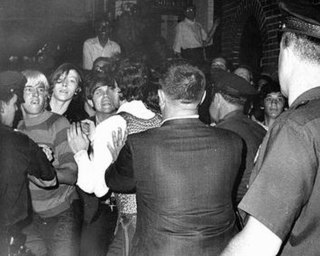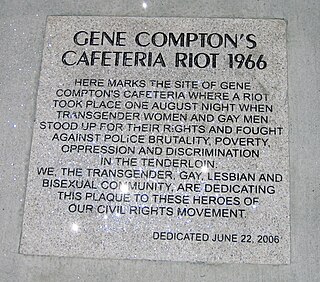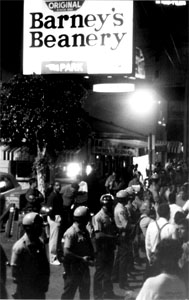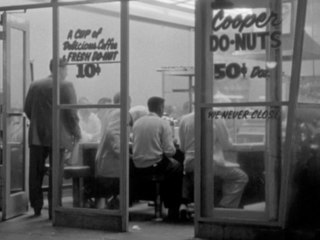History
The bar was established in November 1966; two months later, on New Year's Eve, several plainclothes Los Angeles Police Department officers infiltrated the tavern. [4]
According to local gay newspaper Tangents, "the Black Cat was happy and hopping" before undercover police arrived and started beating patrons as they were ringing in the New Year: "There were colored balloons covering the ceiling ... and three glittering Christmas trees." [5] Moments later, "all hell broke loose." [5] After arresting several patrons for kissing as they celebrated the occasion, [6] the undercover police officers began beating several of the patrons [7] and ultimately arrested fourteen patrons for "assault and public lewdness". [8] Two bartenders were beaten unconscious. [9] Two patrons fled to another gay bar, New Faces, but they were followed by police and arrested. The officers mistook the manager, a woman named Lee Roy, for a man (named "Leroy") wearing a dress, and beat her severely. [10]
Contrary to popular myth, there was not a riot at the Black Cat, but a civil demonstration of 200 attendees to protest the raids was held on February 11, 1967. Demonstrators used "secret phone trees to organize the event" which led to hundreds of people demonstrating and coming to the event. [11] The demonstration was organized by a group called PRIDE (Personal Rights in Defense and Education), founded by Steve Ginsberg, and the SCCRH (Southern California Council on Religion and Homophile). [8] The protest was met by squadrons of armed policemen. [4] Demonstrators carefully adhered to all laws and ordinances so that the police had no legitimate reasons to make arrests. [10] The event was the first organized public LGBTQ protest in Los Angeles, and one of the earliest and largest in the country. [10] This occurred during the governorship of Ronald Reagan, under which a Law and Order mentality reigned and police brutality was systemic. [12]
Two of the men arrested for kissing were later convicted under California Penal Code Section 647 and registered as sex offenders. [8] The men appealed, asserting their right of equal protection under the law, but the U.S. Supreme Court did not accept their case. [3] However, there were fundraising efforts that reached New York and San Francisco for the six convicted patrons, including Benny Baker and Charles Talley.
Legacy
The raid and subsequent protests inspired publication of The Advocate , which began as a newspaper for the group PRIDE. [13] The January 1967 raid on the Black Cat Tavern and the August 1968 raid on The Patch together inspired the formation of the Metropolitan Community Church (led by Pastor Troy Perry). [14] [15]
For some time "the Stonewall riots became central to gay collective memory while other events did not." [16] By pointing to critical moments in LGBT history that took place before 1969, historians continue to challenge the notion that the events at the Stonewall Inn marked the very first time LGBT folks "fought back instead of passively enduring humiliating treatment." [16] Indeed, the 1959 Cooper Donuts Riot [17] and the 1966 Compton's Cafeteria riot predate the incidents at The Black Cat.
On November 7, 2008, the Black Cat site was declared a Los Angeles Historic-Cultural Monument. [8] [18]
In 2014, queer Chicana artist Alma López and students in her "Queer Art in LA" class at UCLA painted a mural depicting the protests. The mural is located in the LGBTQ Studies offices in Haines Hall on the UCLA campus. [19]
On November 14, 2017, the KCET documentary series Lost L.A. included interviews, footage, news coverage, and primary documents about the raid and protests in its episode "Coded Geographies", which situates the November 1966 incident and subsequent protests within the broader LGBTQ culture of Los Angeles. [20] In 2017, a reenactment of the original protest took place on the 50th anniversary of the original protest. There were over one hundred participants, including LA mayor Eric Garcetti, and Alexei Ramanoff who was involved in the original organization of the 1967 protests. People brought signs that reproduced the original signs from the protest. [21] The Black Cat Tavern has recently received state recognition as an official cultural history site. [22]

The Stonewall riots, also known as the Stonewall uprising, Stonewall rebellion, or simply Stonewall, were a series of protests by members of the LGBTQ community in response to a police raid that began in the early morning hours of June 28, 1969, at the Stonewall Inn in the Greenwich Village neighborhood of Lower Manhattan in New York City. Patrons of the Stonewall, other Village lesbian and gay bars, trans activists and unhoused LGBT individuals fought back when the police became violent. The riots are widely considered the watershed event that transformed the gay liberation movement and the twentieth-century fight for LGBT rights in the United States.

The Stonewall Inn is a gay bar and recreational tavern at 53 Christopher Street in the Greenwich Village neighborhood of Manhattan in New York City. It was the site of the 1969 Stonewall riots, which led to the gay liberation movement and the modern fight for LGBT rights in the United States. When the riots occurred, Stonewall was one of a relative few gay bars in New York City. The original gay bar occupied two structures at 51–53 Christopher Street, which were built as horse stables in the 1840s.

Sunset Junction is an informal name for a portion of the Silver Lake district of Los Angeles, California. It was home to the Sunset Junction Street Fair from 1980 through 2010. It is in the southwestern part of the district along Sunset Boulevard.

The gay liberation movement was a social and political movement of the late 1960s through the mid-1980s in the Western world, that urged lesbians and gay men to engage in radical direct action, and to counter societal shame with gay pride. In the feminist spirit of the personal being political, the most basic form of activism was an emphasis on coming out to family, friends, and colleagues, and living life as an openly lesbian or gay person.

The Compton's Cafeteria riot occurred in August 1966 in the Tenderloin district of San Francisco. The riot was a response to the violent and constant police harassment of drag queens and trans people, particularly trans women. The incident was one of the first LGBT-related riots in United States history, preceding the more famous 1969 Stonewall riots in New York City. It marked the beginning of transgender activism in San Francisco.
This is a list of notable events in the history of LGBT rights that took place worldwide in the 1950s.
This is a list of notable events in the history of LGBT rights that took place in the 1960s.

Craig L. Rodwell was an American gay rights activist known for founding the Oscar Wilde Memorial Bookshop on November 24, 1967 - the first bookstore devoted to gay and lesbian authors - and as the prime mover for the creation of the New York City gay pride demonstration. Rodwell, who was already an activist when he participated in the 1969 Stonewall uprising, is considered by some to be the leading gay rights activist in the early, pre-Stonewall, homophile movement of the 1960s.

A zap is a form of political direct action that came into use in the 1970s in the United States. Popularized by the early gay liberation group Gay Activists Alliance, a zap was a raucous public demonstration designed to embarrass a public figure or celebrity while calling the attention of both gays and straights to issues of gay rights.
The Patch was an LGBT bar formerly located at 610 W. Pacific Coast Highway in the Los Angeles neighborhood of Wilmington, California. The Patch, along with the Black Cat Tavern, played a pivotal role in the gay rights movement, when, in August 1968, it was one of the first sites where there was open resistance to the constant police harassment of gay establishments and meeting places in Southern California.
Personal Rights in Defense and Education (PRIDE) was a gay political organization. It was established in 1966 as a radical gay political organization that from its origination set a new tone for gay political groups like the Gay Liberation Front (GLF), ACT UP and the Radical Faeries. PRIDE led aggressive, unapologetic demonstrations against the oppression by the Los Angeles Police Department (LAPD) of gay gatherings or same-sex meetings in the city of Los Angeles. PRIDE's monthly single-page newsletter evolved into The Advocate, the nation's longest running gay news publication.
Aristide "A.J." Laurent was an American publisher and LGBT civil rights advocate. He co-founded The Los Angeles Advocate in 1967 with Sam Allen, Bill Rau, and Richard Mitch.

New York City has been described as the gay capital of the world and the central node of the LGBTQ+ sociopolitical ecosystem, and is home to one of the world's largest LGBTQ populations and the most prominent. Brian Silverman, the author of Frommer's New York City from $90 a Day, wrote the city has "one of the world's largest, loudest, and most powerful LGBT communities", and "Gay and lesbian culture is as much a part of New York's basic identity as yellow cabs, high-rise buildings, and Broadway theatre". LGBT travel guide Queer in the World states, "The fabulosity of Gay New York is unrivaled on Earth, and queer culture seeps into every corner of its five boroughs". LGBT advocate and entertainer Madonna stated metaphorically, "Anyways, not only is New York City the best place in the world because of the queer people here. Let me tell you something, if you can make it here, then you must be queer."

Although often characterized as apolitical, “Los Angeles has provided the setting for many important chapters in the struggle for gay and lesbian community, visibility, and civil rights." Moreover, Los Angeles' LGBT community has historically played a significant role in the development of the entertainment industry.

The Cooper Do-nuts Riot was an alleged uprising in reaction to police harassment of LGBT people at a 24-hour donut cafe in Los Angeles in the 1960s. Whether the riot actually happened, the date, location and whether or not the cafe was a branch of the Cooper chain are all disputed, and there is a lack of contemporary documentary evidence, with the Los Angeles Police Department (LAPD) stating that any records of such event would have been purged years ago.

Stuart Timmons was an American journalist, activist, historian, and award-winning author specializing in LGBT history based in Los Angeles, California. He was the author of The Trouble With Harry Hay: Founder of the Modern Gay Movement and the co-author of Gay L.A.: A History of Sexual Outlaws, Power Politics, and Lipstick Lesbians with Lillian Faderman.

This is a timeline of notable events in the history of the lesbian, gay, bisexual, and transgender community in the United States.

LGBT Pride Month, often shortened to Pride Month, is a month, typically June, dedicated to celebration and commemoration of lesbian, gay, bisexual, asexual and transgender (LGBT) pride. Pride Month began after the Stonewall riots, a series of gay liberation protests in 1969.












